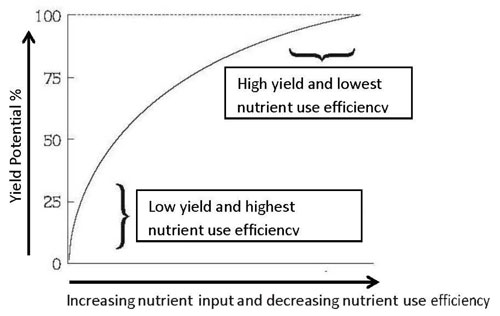Nutrient use efficiency and effectiveness are not necessarily the same
The goal of nutrient management should ideally be to achieve a balance between optimal nutrient use efficiency and optimal crop productivity.
There is considerable interest in improving nutrient use efficiency given the economic, environmental and social challenges facing synthetic fertilizer use in intensive agriculture systems. Nutrient use efficiencies are generally calculated as ratios of nutrient inputs to outputs (crop yield per unit of nutrient applied).
Nutrient use efficiency is somewhat misunderstood. The relationships between nutrient rate, crop yield and nutrient use efficiency are illustrated in Figure 1. The highest nutrient use efficiency occurs at the lower parts of the yield response curve, where fertilizer inputs are lowest. When the soil fertility is low, any small amount of nutrient applied would give a large yield response. If nutrient use efficiency were the only goal, it would be achieved in the lower part of the yield curve. At lower use rates, fertilizers are not effective in achieving the desired food production levels. As you increase the rate, yields continue to increase, but at a slower rate, and nutrient use efficiency typically declines.
Figure 1. Relationship between yield response, nutrient rate and nutrient use efficiency

(Adapted from “The Mysteries (Myths) of Nutrient Use Efficiency,” Better Crops with Plant Food)
Currently, fertilizers are used in 40-60 percent of the world’s food production. By enhancing production, fertilizers spare millions of new acres from being converted to agriculture. The effectiveness of fertilizers in increasing crop yields and optimizing farmer profitability need not be sacrificed for the sake of improving nutrient use efficiency alone.
The 4R’s of nutrient practices, namely applying the right source at the right rate, at the right time, and at the right placement, is a tool that can influence the shape of this curve by reducing nutrient losses to the environment and helping to increase nutrient use efficiency. Nutrient use efficiency is also influenced by site specific soil and climatic factors.
Michigan State University Extension promotes the following for improving nutrient use efficiency while maintaining optimum crop yields:
- Crop genetics and management practices assuring maximum economic yields.
- Enhanced-efficiency fertilizer products using controlled-release technologies.
- Precision agriculture technologies to sense crop needs and match nutrient availability.
- Increased use of on-farm research evaluating nutrient use efficiency.
- Decision support tools that apply science at the farm level.
Because fertilizers are made from non-renewable resources, pressure to increase their use efficiencies will remain. At the same time, efforts to increase effectiveness of fertilizers in terms of productivity and profitability to meet the global food demand needs should continue. Ideally, the goal is to achieve a balance between optimal nutrient use efficiency and optimal crop productivity.



 Print
Print Email
Email




